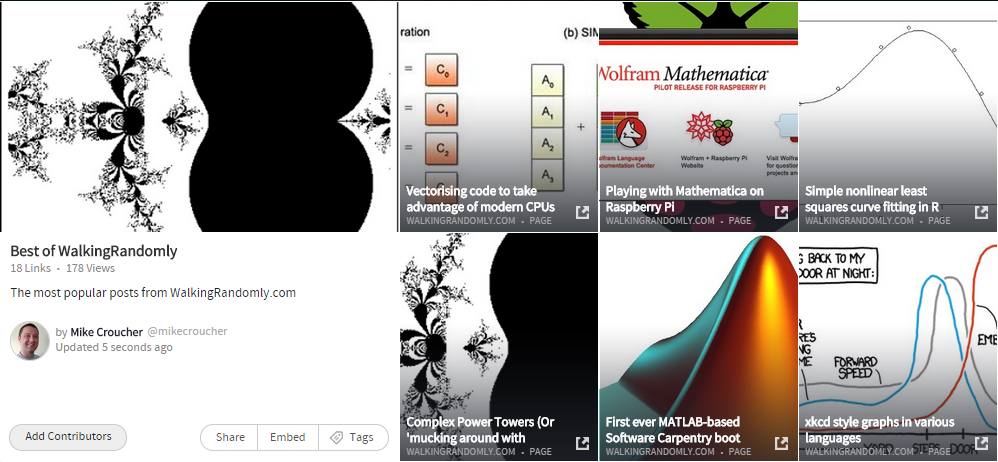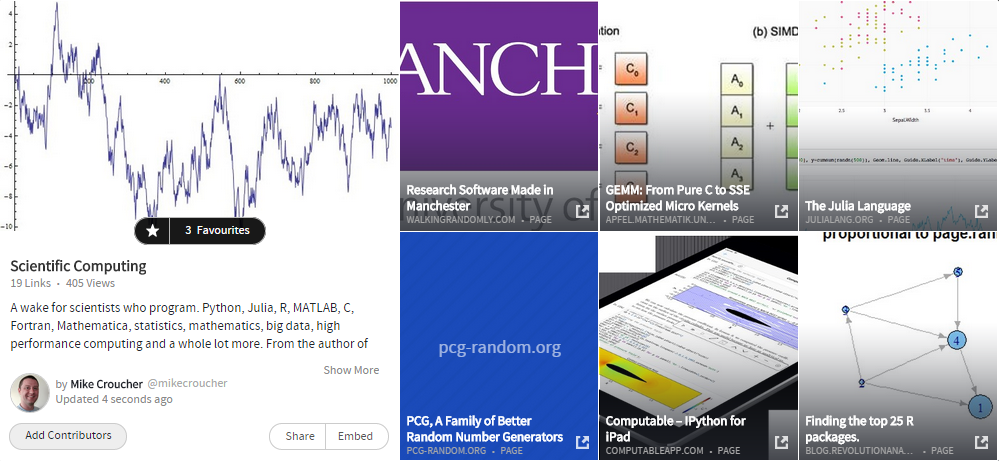Archive for the ‘walking randomly’ Category
Wakelet is a new content curation platform that I’ve been playing with recently and I have to say, I like it a lot! Here’s a screenshot from one of my wakes, ‘Best of WalkingRandomly’ where I’ve gathered together some of the most popular pages here.
A ‘wake’ is a collection of images, notes, comments and links. It sounds simple, and it is, but I’ve found it very useful for all kinds of stuff. For example, whenever I find an interesting article about scientific computing, I usually post it on my twitter feed – https://twitter.com/walkingrandomly. I’ve done this for hundreds of links but they are difficult to subsequently look up. With this in mind, I’ve started adding some of the best links to my Scientific Computing wake.
Wakelet is developed by a group in Manchester and I first learned about it because one of my friends is a developer there. At first, I dutifully played with it because of his involvement but I’ve continued using it’s really rather good! Read more about wakelet:
For almost 10 years now I have been working in scientific applications support at The University of Manchester. It’s been a wonderful decade in which I’ve learned a lot, made many good friends and worked on dozens of collaborations with academic and IT colleagues alike. Since I live in Sheffield, I’ve also spent just over a year of my life on public transport!
It is, however, time for me to move on and I am delighted to announce that, as of 2nd March, I will be moving to The University of Sheffield. My new position is a joint venture between Sheffield’s Corporate Information and Computing Services (CICS) department and Professor Neil Lawrence, an expert in machine learning and computational biology.
I’m really excited about this new position — there’s going to be research computing support, open data science, high performance computing, software carpentry, teaching, code consultancy, GPUs, Python, MATLAB and lots more of the hardware and software technologies that I love so much. The fact that my commute is being reduced from 4 hours a day to 30 minutes a day is just the icing on the cake!
I’d like to publicly thank everyone at The University of Manchester for making my time there so wonderful. The University of Manchester is a truly amazing place in which to work and is chock-full of the most important resource of any organisation – creative, intelligent, driven, passionate and friendly people. I’ve still got 3 months to go before I leave so let’s make sure we get together at least one more time before I go.
I work at The University of Manchester as part of IT Service’s Research Support department. This month, I was given the task of editing the newsletter that we send out to the academics we serve.
For me, this month’s highlights include the fact that our Condor Pool (which I help build and run) has now delivered over 20 million CPU hours to academics at Manchester by making use of desktop PCs around campus. Another HPC system we have at Manchester is our Computational Shared Facility which is jointly funded by the University and all of the research groups who use it. This system has just seen the installation of its 6000-th CPU core.
Other news includes the Greater Manchester Data Dive, an AGM for Research Software Engineers, Image based modelling and more.
If you are interested in seeing the sort of thing we get up to, check out this months newsletter at http://documents.manchester.ac.uk/DocuInfo.aspx?DocID=20995
This year sees the 50th anniversary of the UK’s Institute of Mathematics and its Applications (IMA). As part of the celebrations, the IMA has published a book called 50 Visions of Mathematics.
Edited by Sam Parc, the book contains 50 mini chapters covering many aspects of mathematics written for the general reader. Topics include subjects such as ‘Whats the use of a quadratic equation’, ‘The mathematics of obesity’, ‘A glass of bubbly’ and ‘Motorway Mathematics’. The full list can be found under the ‘Table of Contents’ tab at http://ukcatalogue.oup.com/product/9780198701811.do
The level of mathematics required to understand this book isn’t high at all which makes it suitable for anyone with even a passing interest in the subject.
Along with the 50 essays, there are also 50 full colour mathematical images with number 6 being contributed by yours truly — based on some Mathematica code I wrote a few years ago.
I am currently in the market for a new thin and light laptop; the things that everyone seems to be calling ultrabooks these days. Here’s what I’ve considered so far and the major good/bad points from my point of view.
- 2013 Macbook Air: Good: Fantastic hardware specs including Haswell and Intel HD 5000. I’ll get an educational discount. Bad: No touchscreen, I’m not interested in OS X. No tablet mode.
- Lenovo Yoga 11s. Good: Both a tablet and a laptop but it’s a laptop first and a tablet second. Bad: Only 3rd generation Intel. Weird to hold in laptop mode because your fingers are mashing the keyboard.
- Haswell based Dell XPS 12. Good:Haswell. Beautiful mechanism for switching between tablet/laptop. Bad: Only Intel HD 4400 graphics compared to the Air’s Intel HD 5000. I’ve heard that the connection between computer and screen is unencrypted WiDi. Possibly just FUD but its putting me off right now.
- Samsung Ativ Book 9 Plus Good: Haswell. Amazing display resolution. Bad: Much higher resolution than the Macbook Air but with weaker GPU (Intel HD 4400)–that surely can’t be a good combination? No tablet mode. Win 8 doesn’t handle such high resolution screens well but should be fixed in 8.1.
- Samsung Ativ Q: Good: Haswell. Amazing display resolution. Tablet mode.Win 8+Android. Bad: No trackpad. Looks horrible in laptop mode–seems to be a tablet first and laptop second. Like the Book 9 plus, it has a relatively weak GPU (Intel HD 4400) to drive all those pixels.
I think that at the moment, what I want is the form factor and weight of the Dell XPS12 with the resolution of the Samsung and the hardware specs of the Air. I’m open to suggestions though.
When I first started this blog, there were only really two methods by which readers could keep up with new content – by subscribing to the RSS feed or by regularly dropping by the site to see what’s new. Since then readers have steadily been requesting other ways to follow the blog and, for the most part, I have obliged. Here’s a list of current methods:
- Subscribe to the RSS feed
- Follow me on Twitter – I post every WR article to my twitter feed along with whatever else I find interesting. Twitter is also a great way of contacting me and is the social media platform on which I am most active.
- WalkingRandomly on Facebook – A small following compared to the other channels but useful to some it seems.
- Drop by the site whenever the mood strikes you
I know it’s a day late but someone just sent me this and I simply had to share so please indulge me. Solve this inequality to find the love
9x-7i>3(3x-7u)
One of the benefits of working at a university is that you are surrounded by a lot of smart people doing very interesting things and it usually doesn’t take much effort to get them to talk about their research. I work in the faculty of Engineering and Physical Sciences which means that I’m pretty well covered in subjects such as mathematics, physics, chemistry, engineering, computer science, materials and earth sciences but I have to go all the way to the other side of campus if I want to learn a little about the life sciences.
Last week, I attended a free event called The Rogue Cell which was arranged by The Wellcome Trust Centre for Cell-Matrix Research and hosted by The Manchester Museum as part of World Cancer Day. I had no idea what to expect out of the evening but if you were to press me I would have guessed that there was going to be a lot of power point slides and row upon row of gently dozing delegates. I could not have been more wrong.
The event was arranged in a workshop format where all of the attendees were split into five groups of six or so. Each group was then assigned a Wellcome Trust Researcher who’s job it was to explain to us one of five defining characteristics of a cancer cell which were
- Evading the immune system
- Angiogenesis (formation of blood vessels)
- Migration/invasion
- Proliferation
- Lack of apoptosis (programmed cell death).
Each group kept their researcher for 20 minutes or so before they got assigned a new one who discussed a different topic from the five. So, by the end of the evening we had covered the lot. The presentations were intimate, informal and highly interactive and it felt to me like I was having a good chat down my local pub with a group of people who just happened to be world-class cancer researchers. If only all learning experiences were like this one!
There was a great cross section of attendees from PhD biology students through to clinicians, undergraduates, random people off the street and, of course, the occasional math software geek. One of the great things about this event was the fact that everyone seemed to get a lot out of it, no matter what their background. I asked a lot of questions, many of which would have been blindingly obvious to a student of the life sciences but not once was I made to feel stupid or out of place. It must have been exhausting for the presenters but I can honestly say that it was one of the most enjoyable learning experiences I’ve had for quite some time.
I sincerely hope that The Wellcome Trust Centre for Cell-Matrix Research and The Manchester Museum will be arranging more events like this in the future.
Links:
The following links were sent to us following the event. I include them here for anyone who’s interested.
Evasion of Immune System:
- New cancer therapy:http://www.youtube.com/watch?v=t3bI9nBa4FY
- Herceptin mechanism of action:http://www.youtube.com/watch?v=IeE3K7U9fTQ
Migration/Invasion
Proliferation
- http://www.cancerresearchuk.org/cancer-info/prod_consump/groups/cr_common/@nre/@car/@gen/documents/flash/018206.swf
- http://www.youtube.com/watch?v=IeUANxFVXKc&feature=related
- http://www.youtube.com/watch?v=Hm03rCUODqg&feature=related
Angiogenesis
I am having a friendly argument with a colleague over how you calculate the peak number of floating operations per second (flops) for devices that support Fused Multiply Add (FMA). The FMA operation is d=a+b*c, an operation that can be done in one cycle on devices that support it.
I say that an FMA operation is two flops, he says it’s one. So, when I calculate the theoretical peak of a device I get twice the value he does. So, what do you think..is FMA one flop or two?
I like the StackOverflow range of question and answer sites and have hopped on and off them almost since the very beginning. When I logged in recently I was informed that one of my questions had been awarded the ‘Famous Question’ badge..i.e. it had been viewed over 10,000 times. The relevant question was Python blogs that you regularly follow? which was asked by me in the very early days of the site. Not only has it received 63 community up-votes and over 10,000 views but it’s also been closed as ‘Not constructive’ by senior members of the Stack Overflow community.
I find this contrast amusing!



